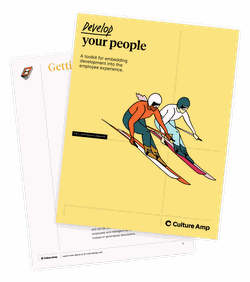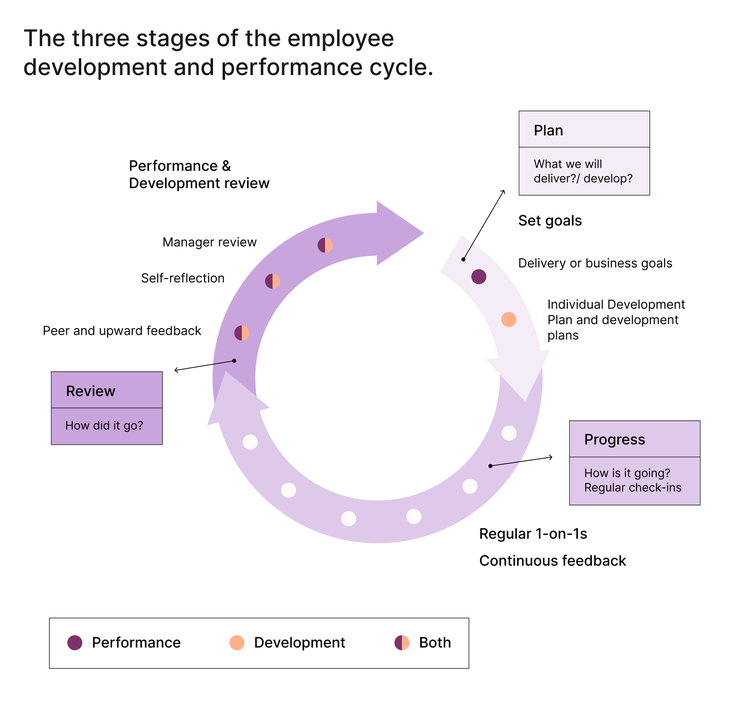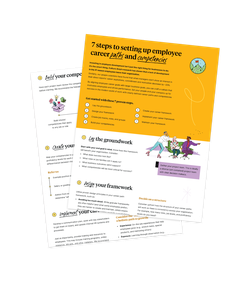
While it’s a key element of the employee experience, professional development is often overlooked. Many companies lack a structured learning and development (L&D) strategy and formal career growth resources, and this could be holding them back. Culture Amp data shows that employees who don’t have access to meaningful L&D opportunities are two times more likely to leave an organization within a year. Development is the second most influential driver of engagement.
To engage and retain top talent, organizations must invest in personalized, continuous, and measurable employee development. When employees see and understand their opportunities to learn, grow, and advance within your company, they’re more likely to stay engaged and committed and envision a long-term future with your organization.
Whether you’re ready to refine your existing development tools or build a new strategy, the right employee development framework can empower managers, support tailored growth, and embed development into the daily employee experience. This guide covers the fundamentals of employee development, from leading effective development conversations to tailoring growth based on individual employee needs, and shares how to make a growth mindset part of your organization's DNA.
Employee development: What it is and why it matters
Employee development is a collaborative effort between employers and employees to enhance skills, expand knowledge, and support career growth. You may also hear it referred to as professional development, staff development, capacity building, or career development.
Building a strong development culture doesn’t have to be a complex endeavor. Instead, focus on the fundamentals – help your managers and employees create meaningful development plans and have effective growth conversations. Two powerful models can serve as a guide: the 3 E’s of development and the GROW coaching model.
The 3 E’s of development provide a framework for crafting well-rounded development plans by incorporating different types of learning experiences:
- Experience: On-the-job experiences that help employees grow (e.g., stretch tasks, special products, mentoring others, etc.)
- Exposure: Learning through observation (e.g., working with a coach, seeking feedback, job shadowing, networking, etc.)
- Education: Structured learning (e.g., courses, books, conferences)
You can also use the GROW coaching model, which is a model designed for solving problems, setting goals, and improving individual performance. The acronym GROW stands for:
- Goal, or what an individual is looking to achieve
- Reality, or the facts of the current situation
- Options/Obstacles, or all the different ways you can address the situation
- Will/Way forward, or how you will choose to act

By using these approaches to create a culture that embeds employee development into day-to-day work, performance reviews, and 1-on-1 conversations, you’ll help managers better support their team’s growth. You’ll also create a workforce of employees who feel their success is valued, leading to better business outcomes.
When we frame learning (using a tool like the 3 E’s) as a more holistic and nuanced range of activities, we help employees recognize that development happens every day and isn’t just limited to attending a course.
Dany Holbrook
Senior People Scientist at Culture Amp

Refine your employee development strategy
Why is employee development important in the modern workplace?
Today’s employees demand employee development. Culture Amp’s research team has found that one out of three departing employees cited a lack of career growth as a reason for leaving the company. The importance of employee development is also evident in engagement levels – employees were 46 percentage points more engaged when they could develop skills that were relevant to their interests.
Employees are moving to organizations that allow flexible working arrangements, better work/life balance, and stronger growth opportunities. As a result, many companies are prioritizing a new, more personalized perspective on career development. While your organization may already be working to build an employee-first culture, putting these growth opportunities at the forefront is a key factor in how to motivate and develop staff.
While demand for employee development plans is increasing, traditional tools for driving and supporting these opportunities for growth can be cumbersome. They may provide little to no direction, lack a definitive structure, or leave managers with no clear process for guiding their direct reports. Companies need a robust strategy for employee development that provides managers and employees with a clear framework for charting a way forward together.
How to build a future-proof employee development strategy
Every employee’s growth journey is different, so create a development strategy that offers a variety of opportunities catering to diverse learning styles, career aspirations, and skill levels. This makes it easy for employees to access the resources that work best for them – whether that’s mentorship, upskilling, cross-functional projects, or classroom training programs. By providing multiple pathways for learning and career advancement, your business can empower employees to take charge of their own development while ensuring equitable access to growth opportunities across your organization.
Here are a few key ways to make it happen:
1. Align employee development with business goals
At Culture Amp, we believe the “sweet spot” for employee development lies at the intersection of:
- Employee skills and strengths: Leveraging what employees already excel at
- Employee aspirations and motivations: Supporting personal and career growth
- Business needs: Aligning employee development goals with business needs
By combining these three factors, employees can create specific, motivating goals that not only drive personal career growth but also contribute to the organization’s success. When crafting employee development plans, take the time to align individual aspirations with business objectives – this helps individuals see how their role fits into the bigger picture while fostering engagement and long-term employee retention.
2. Craft clear career paths
Career pathing, which lays out the path to a specific position or promotion, brings clarity to teams and individual employees. By creating and sharing clearly defined career paths for the different roles and tracks in your organization, your employees can understand what's possible for them to achieve – and exactly what experience, skills, and competencies it takes to reach the next level of their careers.
3. Foster a culture of continuous learning
To cultivate a strong company culture that truly prioritizes learning and development, embed development into employees’ daily work rather than treating it as a one-time or once-a-year event. Encouraging leaders to model a growth mindset, providing diverse learning opportunities and employee training, recognizing learning efforts, and offering company-wide development programs and processes can help your business build a culture that supports ongoing learning year-round.
4. Create intentional space for learning
Even in companies with a strong learning culture, development can easily take a backseat – especially during busy periods. To make L&D a daily priority, your business must dedicate time and resources so leaders and employees can easily set aside time for their growth.
Here are a few ways to make that a reality:
- Lead by example: Employees take cues from leadership. If managers and executives don’t prioritize L&D, employees may hesitate to invest time in their own development. Encourage leaders to openly participate in learning opportunities, share their experiences, and ask their teams to do the same.
- Set aside time for learning: Create structured opportunities for employees to develop their skills. This could include ongoing workshops, guest speaker sessions, dedicated learning hours, or even company-wide hackathons where employees step outside their daily roles to collaborate on innovative projects.
- Provide access to learning platforms: Give employees flexible learning options tailored to their career growth. Platforms like LinkedIn Learning allow employees to develop skills at their own pace and choose courses that interest them, making learning more accessible and personalized. Alternatively, tools like Culture Amp’s Skills Coach deliver bite-sized, two-minute lessons that help even the busiest managers make time to learn and turn new skills into lasting habits.
Embedding these initiatives into your organization sends a clear message: Employee growth isn’t just encouraged – it’s a priority.
5. Leverage mentorship programs for professional growth
When it comes to promoting employee growth, your current workforce is one of your biggest assets. Pairing employees with a mentor can help them gain valuable insights, develop new skills, and navigate career progression under the guidance of someone more experienced.
Such programs don’t always develop organically, though. Your business must intentionally match and support mentors and mentees to ensure both parties get the most out of the initiative. Here’s how:
- Facilitate meaningful connections: Match mentors and mentees based on criteria like career goals, skills, and areas of expertise or interest to ensure a productive and lasting relationship.
- Encourage reciprocal learning: Mentorship can be just as valuable for mentors as it is for mentees. Both sides have an opportunity to gain fresh perspectives, refine their leadership skills, and develop a deeper understanding of different roles within the company.
- Offer ongoing resources: Provide detailed program guidelines, like how often to meet and what to discuss, to help employees ensure their check-ins are productive.
- Recognize and reward participation: Highlight successful mentor-mentee relationships and acknowledge those who invest time in supporting others’ growth. Celebrating their contributions can also boost future program participation and reinforce a culture of continuous learning and development.
6. Consider the intrinsic synergy between development and performance
Performance and development work in tandem, meaning the employee development cycle works best when it’s deeply integrated into your performance management system. At Culture Amp, our people scientists recommend continuous performance management, which focuses on continuous improvement via regular pulse checks, coaching, and employee development conversations.

Aligning development and performance discussions equips managers and employees to set clear goals, track progress, and measure success more effectively. This integrated approach ensures that development remains an ongoing priority, providing employees with the support and guidance needed to grow while also driving top performance.
7. Understand and address common development planning challenges
While development planning looks relatively simple on an organizational level, many employees experience hesitation and confusion. In these cases, there are four questions you need to clarify upfront to your employees:
- When to create the development plan ("When should I do it?")
- What to include in the development plan ("What should I do?")
- Who else will be involved in the development plan ("Who will help me?")
- How the development plan will be used and kept accountable ("How do I track my progress?")

7 steps to setting up career paths and competencies
Learn how to develop a motivating career framework, set up career paths, and define competencies – all in 7 proven steps.
The best tools and platforms for employee development
Tracking and evolving development plans may feel like an added task for managers who are already stretched thin working to hit targets, keep projects moving, and manage a team. But employees rely on managers for guidance and support when it comes to development.
That’s why reframing L&D as an ongoing, day-to-day part of the employee experience can help managers balance a heavy workload while keeping growth a priority. Managers will be there to guide employees, but employees can own their growth and drive the development process forward.
Rather than relying on a manual approach, consider employee development tools that offer an automated workflow, streamlining the process and reducing the time required by traditional methods. Your employees will shape their own growth trajectories, so start by identifying areas that are important to them.
Develop by Culture Amp empowers managers to have more meaningful conversations with their direct reports to explore and understand their employees’ personal motivators. Here’s how:
- Create an individual development plan: Employees can craft their own development plans with the help of their managers, ensuring that the plan and the associated goals are well-aligned with team and organizational goals.
- Conduct a development conversation: Managers can access an employee’s individual development plans in-platform, making it easy for them to understand each employee’s desires. From there, they can work together with the employee to identify specific goals that benefit both the employee and the business.
- Put the plan into action: Once managers have helped determine the next steps and OK’d the plan, employees can own their growth by completing tasks within their personalized development plan.
- Circle back: Throughout the year, managers and employees meet to track plan progress, share feedback, and revise plans as needed to ensure employees are making good progress and getting closer to their career goals.
Tools like Culture Amp empower employees to take a strategic and thoughtful approach to development – one that inspires them to grow their skills while also supporting your business’s success.
Measuring the impact of employee development programs
Measuring and tracking employee sentiment around development empowers you to prioritize L&D initiatives and demonstrate business impact. When starting out, the following three indicators will help you understand the impact of your employee development strategy. You can use the insights they provide to continue evolving your approach:
Analyze how employees engage with training and development resources
Understand how your employees engage with your employee development tools. Solutions like Develop and Skills Coach by Culture Amp make it easy to access data on development activities and find out how your employees use these tools. You can even drill deeper into the data on participation by demographic variables to identify any discrepancies.
Leverage employee surveys for insights
Use engagement and pulse survey results to learn how employees feel about their professional development process. Consider the following statements to gauge employee sentiment and understand where your business can improve your development programs:
For more immediate, short-term insights via development tools and pulse surveys:
- I have a clear sense of my development goals
- I have a clear understanding of the skills and knowledge I need to develop
- I am clear where I want to be in my career or job in a few years’ time
For longer-term sentiment analysis via engagement surveys:
- I have access to the learning and development I need to do my job well
- I am given opportunities to develop skills relevant to my interests
- My manager has shown a genuine interest in my career aspirations
- [Company] is a great place for me to make a contribution to my development
- I believe there are good career opportunities for me at [Company]
Prioritize employee growth for long-term success
Collect data on what employees want and need to learn. Insights into development needs and interests could include:
- Development focus - e.g., developing in current role vs., looking for a new opportunity
- Top growth areas (skills)
- Top self-reported strengths (skills)
- Most motivating aspect of work
- Least motivating aspects of work
While these indicators can be tracked manually, tools like Develop automatically aggregate this data into a centralized view to help you prioritize the most valuable L&D initiatives at scale.
Track key performance metrics to measure employee growth effectively
To understand the impact of employee development efforts, track key performance metrics that go beyond participation rates to measure skill application, mobility, and business outcomes.
Key short-term performance metrics
- Employee development plan adoption and completion rates: Use development software to monitor how many employees actively set and achieve their personal growth goals.
- Employee learning participation and completion: Measure engagement in workshops, certifications, and on-the-job learning initiatives.
- Skill development and capability building: Use self-assessments, manager feedback, and performance data to evaluate how development efforts translate into improved skills and employee effectiveness.
Longer-term performance metrics
- Career growth and mobility: Track promotions, lateral moves, skill-based projects, and leadership pipeline progression to assess how well development pathways support career agility.
- Employee experience and growth sentiment: Use pulse surveys and qualitative feedback to understand if employees feel they have the proper support, visibility, and access to career opportunities.
- Retention and business impact: Analyze how development investments correlate with key business priorities such as retention and engagement.
- Knowledge retention and skill progression: Conduct pre- and post-training surveys to measure how well employees retain and apply newly acquired skills in their roles.
Organizations can consistently track development effectiveness, not just activity, refine their strategies, remove barriers to growth, and build a culture where employees thrive.
Making employee development practices strategic
Culture Amp research shows that companies prioritizing L&D as a facet of the employee experience see:
Statistics
-
24.3%
growth. Companies with a culture of development grew on average 24.3% points more than those without one
-
46%
higher engagement for employees whose skills are being built in line with their interests
-
21%
more motivated employees
The results are in – an investment in employee development is crucial for keeping your business ahead in today’s world of work. Executive teams are continually presented with competing priorities, but with development as a core element of your business strategy, you’ll be on track to growing and retaining your people at scale. When you intentionally nurture the goals and interests of your people, you boost engagement, satisfy employees, and support better business outcomes.
How to get started with an effective employee development plan
When you invest in employee training and development, you’re investing in your business. Personalized and continuous employee growth helps managers align the company’s vision with the career goals of their direct reports and instills confidence in employees that the work they do contributes to a larger purpose.
Employees want to know where they fit in your organization – not just today, but in the future. Instead of waiting until your employees seek growth opportunities elsewhere, develop and retain your people now, and reap the rewards. Develop by Culture Amp is an effective tool for building an employee development strategy that works for your people and your business.
Backed by rigorous people science, Develop makes it easy to unlock measurable, scalable, and easy professional development. Here are three ways to leverage Develop today:
- Paint a motivating future for your employees. Use Develop’s simple, centralized competency frameworks and career paths to provide employees with specific requirements for success at your organization. Employees can set and update development goals right in the platform, giving managers visibility into how their direct reports are growing over time.
- Empower managers to support employee growth. Make meaningful and frequent growth discussions easier for your managers. Managers and employees can easily access and collaborate on individual development plans and goals, making it simple to revisit and adapt development as times and priorities change.
- Demonstrate L&D impact. Track development initiatives and show positive impact – all in one powerful central dashboard. Use the insights from Develop to gain leadership buy-in, determine the most valuable initiatives to invest in, and ultimately take a more strategic and thoughtful approach to employee development.
Built for individuals, teams, and the wider company, Develop by Culture Amp provides all the tools you need to help your people grow with your organization, including Career Paths, a tool for providing clarity around career progression and role expectations to every employee.
Build a workplace where employees grow and thrive. !




